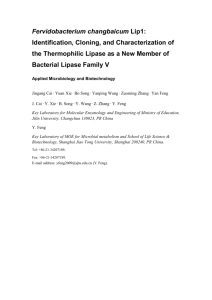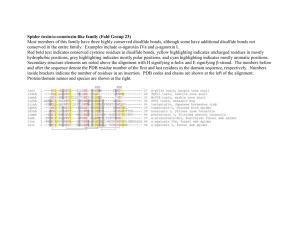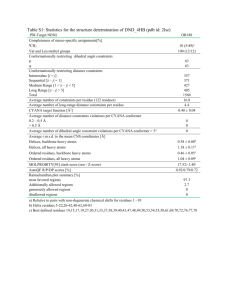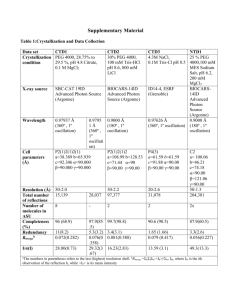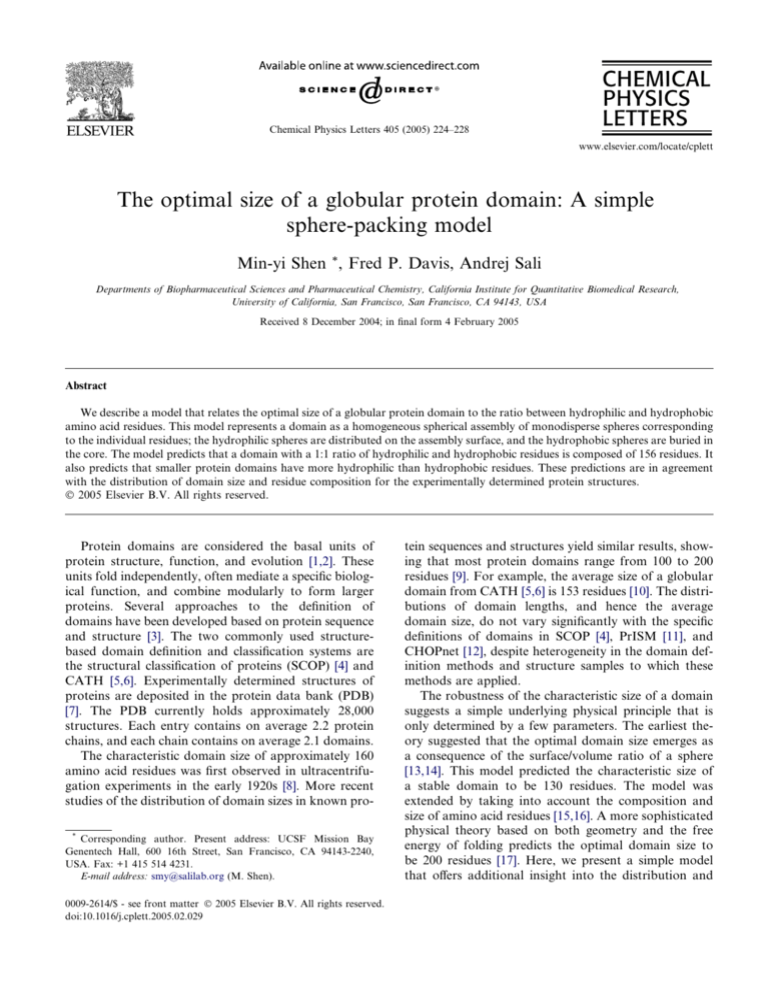
Chemical Physics Letters 405 (2005) 224–228
www.elsevier.com/locate/cplett
The optimal size of a globular protein domain: A simple
sphere-packing model
Min-yi Shen *, Fred P. Davis, Andrej Sali
Departments of Biopharmaceutical Sciences and Pharmaceutical Chemistry, California Institute for Quantitative Biomedical Research,
University of California, San Francisco, San Francisco, CA 94143, USA
Received 8 December 2004; in final form 4 February 2005
Abstract
We describe a model that relates the optimal size of a globular protein domain to the ratio between hydrophilic and hydrophobic
amino acid residues. This model represents a domain as a homogeneous spherical assembly of monodisperse spheres corresponding
to the individual residues; the hydrophilic spheres are distributed on the assembly surface, and the hydrophobic spheres are buried in
the core. The model predicts that a domain with a 1:1 ratio of hydrophilic and hydrophobic residues is composed of 156 residues. It
also predicts that smaller protein domains have more hydrophilic than hydrophobic residues. These predictions are in agreement
with the distribution of domain size and residue composition for the experimentally determined protein structures.
Ó 2005 Elsevier B.V. All rights reserved.
Protein domains are considered the basal units of
protein structure, function, and evolution [1,2]. These
units fold independently, often mediate a specific biological function, and combine modularly to form larger
proteins. Several approaches to the definition of
domains have been developed based on protein sequence
and structure [3]. The two commonly used structurebased domain definition and classification systems are
the structural classification of proteins (SCOP) [4] and
CATH [5,6]. Experimentally determined structures of
proteins are deposited in the protein data bank (PDB)
[7]. The PDB currently holds approximately 28,000
structures. Each entry contains on average 2.2 protein
chains, and each chain contains on average 2.1 domains.
The characteristic domain size of approximately 160
amino acid residues was first observed in ultracentrifugation experiments in the early 1920s [8]. More recent
studies of the distribution of domain sizes in known pro*
Corresponding author. Present address: UCSF Mission Bay
Genentech Hall, 600 16th Street, San Francisco, CA 94143-2240,
USA. Fax: +1 415 514 4231.
E-mail address: smy@salilab.org (M. Shen).
0009-2614/$ - see front matter Ó 2005 Elsevier B.V. All rights reserved.
doi:10.1016/j.cplett.2005.02.029
tein sequences and structures yield similar results, showing that most protein domains range from 100 to 200
residues [9]. For example, the average size of a globular
domain from CATH [5,6] is 153 residues [10]. The distributions of domain lengths, and hence the average
domain size, do not vary significantly with the specific
definitions of domains in SCOP [4], PrISM [11], and
CHOPnet [12], despite heterogeneity in the domain definition methods and structure samples to which these
methods are applied.
The robustness of the characteristic size of a domain
suggests a simple underlying physical principle that is
only determined by a few parameters. The earliest theory suggested that the optimal domain size emerges as
a consequence of the surface/volume ratio of a sphere
[13,14]. This model predicted the characteristic size of
a stable domain to be 130 residues. The model was
extended by taking into account the composition and
size of amino acid residues [15,16]. A more sophisticated
physical theory based on both geometry and the free
energy of folding predicts the optimal domain size to
be 200 residues [17]. Here, we present a simple model
that offers additional insight into the distribution and
M. Shen et al. / Chemical Physics Letters 405 (2005) 224–228
average of the domain sizes observed in natural
proteins.
We begin by modeling a globular protein domain as
an assembly of randomly packed beads that represent
individual residues. On average, a randomly packed
spherical assembly consisting of N residues of the same
size occupies a volume of
Va ¼
4N pa3
;
3a
ð1Þ
where a is the radius of the beads (typically 3.5 Å) representing individual residues and a is the packing ratio of
monodisperse three-dimensional (3D) spheres in the
random close packing (RCP) state [18–20]. As shown
robustly by many simulations and experiments, the packing ratio a is approximately 0.64, which
pffiffiffiffiffi is significantly
smaller than the packing ratio of p= 18 0:74 for the
face-centered packing [19,20]. The concept of the RCP
state has been superceded by the maximally random
jammed (MRJ) state [19], which is physically better
defined than the RCP state and has an essentially
indistinguishable packing ratio of 0.637 [18,21].
Amino acid residues of different aqueous affinities,
namely the hydrophobic and hydrophilic residues, have
different spatial distributions in the native protein structures, reflecting the so-called Ôminimum conditionÕ for a
globular protein domain [9,13]. The hydrophobic residues tend to be buried in the core of a protein, whereas
the hydrophilic residues tend to distribute on the surface. This simplified scheme of residue type classification, known as the HP model [22,23], has been applied
to the study of many aspects of protein folding kinetics.
Given the HP model, an ideal assembly of N beads
has cN hydrophilic beads on the assembly surface and
the remaining (1 c)N hydrophobic beads buried in
the assembly core, where c is the fraction of hydrophilic
residues in the sequence of the domain. The c and N are
not independent variables. To satisfy the Ôminimum conditionÕ for a globular domain, the c and N must be
related to each other. We refer to the corresponding N
as optimal (Nopt) given a composition ratio c and to
the corresponding c as optimal (copt) given a domain size
N. When the beads cluster into a spherical assembly, the
surface area of the assembly is
2=3
N
Aa ¼ 4pa2
:
ð2Þ
a
To proceed, we make a ÔsimplexÕ approximation that all
the hydrophilic surface beads have half of their surface
exposed to the solvent. Under this assumption, the total
effective surface area of the hydrophilic residues is
Aa ¼ 2cN pa2 :
ð3Þ
The optimal value of N for a given residue type composition c can be immediately obtained from equating Eqs.
(2) and (3):
N opt ¼
8
c 3 a2
225
ð4Þ
:
Next, we determine the composition c for the natural
protein sequences. The residue types were divided into
the hydrophobic and hydrophilic classes, as defined in
the Rasmol program [24]. For the entire SwissProt protein sequence database (release 44, July, 2004) [25], the
fraction of hydrophilic residues (c) is 0.507. When a
domain has this composition, our model indicates that
the optimal size is approximately 150 residues (Eq. (4),
for comparison, Nopt is 156 when c = 0.5). This number
is in excellent agreement with domain sizes observed in
natural proteins (above). Conversely, we can also use
the average domain size in the CATH database
(N = 153 residues) to calculate copt of approximately
0.504 (Eq. (4)). Therefore, from both perspectives, our
simple model is in a good agreement with the actual
data.
Next, we refine the model to estimate the upper and
lower bounds on the optimal domain size. These
bounds result from more realistic estimates of the minimal and maximal number of surface residues. The surface residues are defined to be the beads that are
accessible to an external probe sphere, such as the
water molecule with an effective radius of 1.4 Å. The
lower bound on the domain size is determined by finding the most economical way to configure a single layer
of surface residues while keeping the hydrophobic core
inaccessible from water molecules. To shield the hydrophobic core residues from water molecules, the surface
residues do not necessarily need to be in close contact.
Instead, two surface residues can be up to 2(a + 1.4) Å
apart and still prevent the water molecule from penetrating into the space between these two residues.
Therefore, we model the sparsest packing of surface
residues that still shields the core by a group of beads
with a separation of 2(a + 1.4) Å (Fig. 1). According to
this model, the estimated lower bound on the surface
residue area is
2
Aa ¼
cN pða þ rw Þ
;
b
ð5Þ
where rw and b are the characteristic radius of the
water molecule and the RCP packing ratio for twodimensional (2D) disks, respectively. The exact value
of the RCP packing ratio is not known as accurately
in 2D as it is in 3D, because a dense fluid is less
jammed in 2D than in 3D [26]. Reasonable estimates
rangepfrom
ffiffiffiffiffi 0.86 to 0.89 (the densest 2D packing ratio
is p= 12 0:91). From Eqs. (2) and (5), the lower
bound on the optimum size of the globular
domain is
N opt ¼
64b3 a6
c3 a2 ða þ rw Þ
6
:
ð6Þ
226
M. Shen et al. / Chemical Physics Letters 405 (2005) 224–228
in close contact with a second shell residue buried to a
depth of jmaxa (Fig. 2). With simple algebra, we obtain
jmax = 2a/(a + rw) 1.43, which implies the depth of the
maximally buried solvent accessible residues is approximately 1.43a, which corresponds to 5.0 Å for the 3.5 Å
residue radius a. This maximum burial depth of 5.0 Å
agrees well with the conventional definition of a Ôsurface
residueÕ.
With the average residue density and radius of the
spherical assembly of 3a/(4pa3) and (N/a)1/3a, respectively, the expected number of hydrophilic residues in
the first and second shell is
N hydrophilic ¼ aj3 3a2=3 j2 N 1=3 þ 3a1=3 jN 2=3 :
For reasonable parameter values (c = 0.5, a = 3.5 Å,
rw = 1.4 Å, a = 0.64, and b = 0.88), the lower bound on
the domain size is approximately 117 residues.
As mentioned previously, the lower bound on the
optimal domain size was calculated by assuming that
the residues in the outermost exposed shell are hydrophilic and the rest of them are hydrophobic. In contrast,
we estimate the upper bound on the optimal domain size
by assuming that the potentially accessible residues in
the first two outermost shells are hydrophilic while the
rest of them are hydrophobic. We rationalize this choice
as follows. Initially, we have to determine how deeply a
residue can reside from the surface of a well-packed
spherical assembly while remaining solvent accessible.
The first shell residues are defined to have an average
depth of zero (Fig. 2), but the second shell residues have
a variety of burial depths. A residue that is buried in a
second shell right below a first shell residue would have
no chance of being exposed to the solvent because it is
totally eclipsed by the first shell residues. A model for
a maximally buried surface residue describes a pair of
surface residues separated by a water sphere, which is
If we again assume that the hydrophilic residues correspond to one half of the residues (Nhydrophilic
(Nopt) = cNopt, c = 0.5) in the assembly, the upper bound
on the optimal domain size is 213 residues. The explicit
expression for the upper bound on the optimal size is
complicated and is not presented here.
In summary, our highly simplified sphere-packing
model suggests that the optimal size of a globular
domain ranges from 117 to 213 residues, with an average
of 165 residues. These values are close to the results
obtained based on the simplex approximation (Eq. (4)).
The optimal domain size depends on the residue type
composition (Fig. 3). The left hand side of the plot corresponds to the case of over-representing hydrophilic
residues in a protein domain. In such a case, the domain
size should be smaller to retain greater surface/core ratio. In other words, for domains smaller than the optimal size, the simplex approximation predicts the
following dependence of the optimal hydrophobic content c0opt ¼ 1 copt on the domain size N:
rffiffiffiffiffiffiffiffi
8
3
0
copt ¼ 1 :
ð8Þ
2
aN
350
Nopt (Number of Residues)
Fig. 1. The sparsest packing of surface beads that still shields the
buried beads from water. Gray disks represent the 2D surface
projections of the residue beads, with a maximum separation of rw
as denoted by the dashed circles.
ð7Þ
300
250
200
150
100
0.44
0.46
0.48
0.5
0.52
0.54
0.56
Fraction of Hydrophobic Residues
Fig. 2. The densest surface packing. The white, striped and gray
spheres denote a water molecule, first shell residues, and an accessible
second shell residue, respectively. The maximum burial depth is jmaxa.
Fig. 3. The dependence of the optimal domain size on the residue type
composition. Top (dashed), middle (bold), and bottom curves indicate
the upper bound, simplex approximation, and lower bound estimates,
respectively. The 1:1 hydrophilic/hydrophobic ratio is indicated by a
vertical dashed line.
M. Shen et al. / Chemical Physics Letters 405 (2005) 224–228
Next, we compare the dependence of the domain size on
the content of hydrophobic residues as observed in the
ASTRAL 1.65 database [27,28] with that calculated
from Eq. (8) (Fig. 4). The two curves agree qualitatively,
sharing a nearly identical minimal domain size of 20
residues and the increase of domain size as a function
of hydrophobic content. On the other hand, larger
domains are not observed to have greater hydrophobic
content as the theory predicts, suggesting they may
retain the nearly 1:1 hydrophilic–hydrophobic ratio by
an increase of the surface area.
Above, we assumed a perfectly spherical assembly of
residues with an entirely polar coat. However, many
domains are not spherical. Moreover, domains in multi-domain proteins and protein assemblies interact with
each other via substantially hydrophobic interfaces
[29]. Therefore, to make our model more realistic, we
now generalize it to an ellipsoid domain with an aspect
ratio e(e = 1 for a sphere) and only a fraction
f(0 6 f 6 1) of its coat covered by polar residues. Following the arguments for the simplex approximation,
the optimal domain size is
8
pffiffiffiffiffiffiffiffiffiffi3
>
e2 sin1
11=e2
>
f3
>
pffiffiffiffiffiffiffi
1þ
; e > 1;
>
3 a2 e2
2 1
>
c
e
>
>
>
< 8f 3
e ¼ 1;
N opt ¼ c3 a2 ;
ð9Þ
>
3
p
ffiffiffiffiffiffiffiffiffiffi
>
> f3
1
2
2
>
e sinh ð 1=e 1Þ
>
pffiffiffiffiffiffiffi
>
1þ
; 0 < e < 1:
>
c3 a2 e2
1e2
>
:
Eq. (9) relates four variables: the hydrophilic residue
content, surface polarity, protein size, and eccentricity
of a protein. For a constant domain size, the hydrophilic
content c reaches the minimum value at e = 1. This conclusion resembles the prediction by Fisher [16], which
states that a spherical structure has the minimum polar-
227
ity ratio for any given protein size due to the isoperimetric theorem. Conversely, the assembly can be spherical if
and only if Na2(c/f)3 = 8; any non-negative deviation
from this relation will lead to aspheric proteins (cf.
Na2(c/f)3 P 8). Indeed, real small domains (25–50 residues) usually have greater hydrophobic residue content
than predicted by the simplex theory for a spherical
structure (Fig. 4). Because small domains do not have
a truly buried core [16], the excess hydrophobic residues
must be distributed on the protein surface, which leads
to c/f 1, such that Na2(c/f)3 0.41N is always greater
than 8 for 25 6 N 6 50. From this derivation, we deduce
that the actual small domains have aspheric shape
mainly due to the excess surface hydrophobicity.
In conclusion, we found that the optimal domain size
depends strongly on the 3D RCP packing ratio and the
hydrophilic/hydrophobic ratio. In contrast, the optimal
domain size depends relatively weakly on the sizes of
the water molecule and amino acid residues (cf. the simplex model is independent of the amino acid residue and
water radii). The 3D random packing ratio should be
considered as a rather universal constant, as it is characteristic of many packing problems. Hence, the only
ÔtunableÕ parameter in this model is the hydrophilic-tohydrophobic residue ratio. Does the optimal surface/
core ratio arising from geometry as defined in our model
steer the evolution of the actual hydrophilic/hydrophobic ratio observed in real proteins, which subsequently
determines the domain size? One practical application
of our model may be to provide some guidance to the
algorithms that aim to define the domains in protein
sequences [4–6,11,12].
Acknowledgments
We thank Profs. Ken Dill and Karl Freed for commenting on this manuscript. Helpful discussions with
Dr. Huafeng Xu, Dr. Frank Alber, Dr. Damien Devos,
David Eramian and Dr. Bianxiao Cui are also acknowledged. This work was supported in part by the NIH/
NIGMS Grant to A.S. (R01 GM54762).
1
0.8
0.6
References
c’
0.4
0.2
0
25
50
75
100
125
150
Domain Size (Number of Residues)
Fig. 4. The dependence of the hydrophobicity on the optimal domain
size for domains smaller than 170 residues. The simplex approximation
(Eq. (8); solid line). For single domains in SCOP classes a, b, c, and d
in ASTRAL 1.65 (dashed line).
[1] C. Vogel, M. Bashton, N.D. Kerrison, C. Chothia, S.A. Teichmann, Curr. Opin. Struct. Biol. 14 (2004) 208.
[2] C.P. Ponting, R.R. Russell, Annu. Rev. Biophys. Biomol. Struct.
31 (2002) 45.
[3] S. Veretnik, P.E. Bourne, N.N. Alexandrov, I.N. Shindyalov, J.
Mol. Biol. 339 (2004) 647.
[4] L. Lo Conte, B. Ailey, T.J. Hubbard, S.E. Brenner, A.G. Murzin,
C. Chothia, Nucleic Acids Res. 28 (2000) 257.
[5] C.A. Orengo, A.D. Michie, S. Jones, D.T. Jones, M.B. Swindells,
J.M. Thornton, Structure 5 (1997) 1093.
[6] C.A. Orengo, F.M. Pearl, J.M. Thornton, Meth. Biochem. Anal.
44 (2003) 249.
228
M. Shen et al. / Chemical Physics Letters 405 (2005) 224–228
[7] H.M. Berman, J. Westbrook, Z. Feng, G. Gilliland, T.N. Bhat,
H. Weissig, I.N. Shindyalov, P.E. Bourne, Nucleic Acids Res.
28 (2000) 235.
[8] T. Svedberg, Nature 123 (1929) 871.
[9] E.N. Trifonov, I.N. Berezovsky, Curr. Opin. Struct. Biol. 13
(2003) 110.
[10] S.K. Burley, Nat. Struct. Biol. 7 (Suppl.) (2000) 932.
[11] A.S. Yang, B. Honig, J. Mol. Biol. 301 (2000) 679.
[12] J. Liu, B. Rost, Nucleic Acids Res. 32 (2004) 3522.
[13] S.E. Bresler, D.L. Talmud, Compt. Rend. Acad. Sci. URSS 43
(1944) 310.
[14] W. Kauzmann, Adv. Prot. Chem. 14 (1959) 1.
[15] R.E. Gates, H.F. Fisher, Proc. Natl. Acad. Sci. USA 68 (1971)
2928.
[16] H.F. Fisher, Proc. Natl. Acad. Sci. USA 51 (1964) 1285.
[17] K.A. Dill, Biochemistry 24 (1985) 1501.
[18] A. Donev, F.H. Stillinger, P.M. Chaikin, S. Torquato, Phys. Rev.
Lett. 92 (2004).
[19] S. Torquato, T.M. Truskett, P.G. Debenedetti, Phys. Rev. Lett.
84 (2000) 2064.
[20] W.M. Visscher, M. Bolsterl, Nature 239 (1972) 504.
[21] A. Donev, I. Cisse, D. Sachs, E. Variano, F.H. Stillinger, R.
Connelly, S. Torquato, P.M. Chaikin, Science 303 (2004) 990.
[22] K.Z. Yue, K.A. Dill, Phys. Rev. E 48 (1993) 2267.
[23] K.A. Dill, K.M. Fiebig, H.S. Chan, Proc. Natl. Acad. Sci. USA
90 (1993) 1942.
[24] R.A. Sayle, E.J. Milner, Trends Biochem. Sci. 20 (1995) 374,
Amino acids A, G, I, L, M, F, P, W and V are classified as
hydrophobic. For more information: http://info.bio.cmu.edu/
Courses/BiochemMols/RasFrames/PSTABLE.HTM.
[25] A. Bairoch, B. Boeckmann, S. Ferro, E. Gasteiger, Brief Bioinform. 5 (2004) 39.
[26] A. Donev, S. Torquato, F.H. Stillinger, R. Connelly, J. Appl.
Phys. 95 (2004) 989.
[27] J.M. Chandonia, G. Hon, N.S. Walker, L. Lo Conte, P. Koehl,
M. Levitt, S.E. Brenner, Nucleic Acids Res. 32 (Database issue)
(2004) D189.
[28] J.M. Chandonia, N.S. Walker, L. Lo Conte, P. Koehl, M. Levitt,
S.E. Brenner, Nucleic Acids Res. 30 (2002) 260.
[29] J. Janin, S. Miller, C. Chothia, J. Mol. Biol. 204 (1988) 155.



